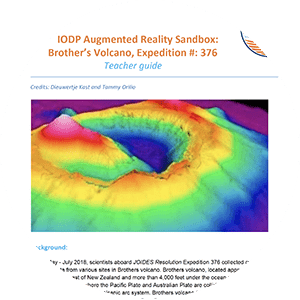Actvity Summary: Students use an Augmented Reality sandbox to understand several earth science processes and specifically create representations of the authentic multibeam sonar projections from the expeditions of the JOIDES Resolution as part of the International Oceanic Discovery Program (IODP).
From May – July 2018, scientists aboard JOIDES Resolution Expedition 376 collected core and borehole data from various sites in Brothers volcano. Brothers volcano, located approximately 300 miles northeast of New Zealand and more than 4,000 feet under the ocean surface, formed at a subduction zone where the Pacific Plate and Australian Plate are colliding together, and is part of the larger Kermadec volcanic arc system. Brothers volcano (and the rest of the arc volcanoes) is unique in that it is hydrothermally active, releasing heat, metals, and other dissolved chemicals into the surrounding seawater.
The aim of Expedition 376 was to clarify the key processes that distinguish hydrothermal systems of submarine arc volcanoes from those of mid-ocean ridge (spreading center) volcanoes. Fluid and rock samples will be used to determine the composition of hydrothermal fluids, the chemical reactions that take place on the way to the seafloor, how various metals are transported and deposited within the seafloor, and to assess the consequences of toxic and acidic environments for the microorganisms that live in and around the hydrothermal systems. This expedition was the first time the JOIDES Resolution (or any research vessel) drilled into an active underwater volcano!
- Standard E: Earth and space science
- Patterns
- Scale, proportion, quantity
- Developing and using models
- Analyzing and interpreting data
- Constructing explanations and designing solutions
- ESS1. C The history of the planet Earth
- ESS2.B Plate tectonics and large-scale system interactions
